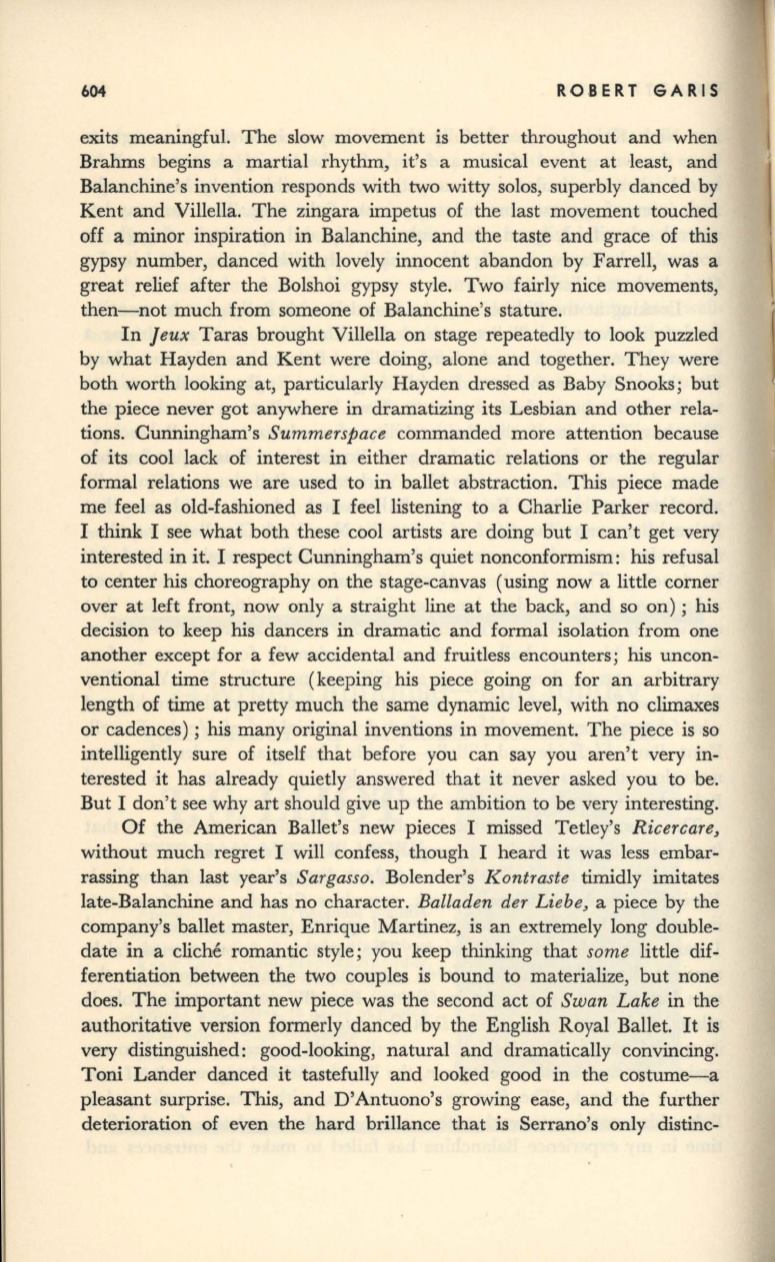
604
RO ,BERT GARIS
exits meaningful. The slow movement is better throughout and when
Brahms begins a martial rhythm, it's a musical event at least, and
Balanchine's invention responds with two witty solos, superbly danced by
Kent and Villella. The zingara impetus of the last movement touched
off a minor inspiration in Balanchine, and the taste and grace of this
gypsy number, danced with lovely innocent abandon by Farrell, was a
great relief after the Bolshoi gypsy style. Two fairly nice movements,
then-not much from someone of Balanchine's stature.
In
Jeux
Taras brought Villella on stage repeatedly to look puzzled
by what Hayden and Kent were doing, alone and together. They were
both worth looking at, particularly Hayden dressed as Baby Snooks; but
the piece never got anywhere in dramatizing its Lesbian and other rela–
tions. Cunningham's
Summerspace
commanded more attention because
of its cool lack of interest in either dramatic relations or the regular
formal relations we are used to in ballet abstraction. This piece made
me feel as old-fashioned as I feel listening to a Charlie Parker record.
I think I see what both these cool artists are doing but I can't get very
interested in it. I respect Cunningham's quiet nonconformism: his refusal
to center his choreography on the stage-canvas (using now a little corner
over at left front, now only a straight line at the back, and so on) ; his
decision to keep his dancers
in
dramatic and formal isolation from one
another except for a few accidental and fruitless encounters; his uncon–
ventional time structure (keeping his piece going on for an arbitrary
length of time at pretty much the same dynamic level, with no climaxes
or cadences) ; his many original inventions in movement. The piece is so
intelligently sure of itself that before you can say you aren't very in–
terested it has already quietly answered that it never asked you to be.
But I don't see why art should give up the ambition to be very interesting.
Of the American Ballet's new pieces I missed Tetley's
Ricercare,
without much regret I will confess, though I heard it was less embar–
rassing than last year's
Sargasso.
Bolender's
Kontraste
timidly imitates
late-Balanchine and has no character.
Balladen der Liebe,
a piece by the
company's ballet master, Enrique Martinez, is an extremely long double–
date in a cliche romantic style; you keep thinking that
some
little dif–
ferentiation between the two couples is bound to materialize, but none
does. The important new piece was the second act of
Swan Lake
in the
authoritative version formerly danced by the English Royal Ballet. It is
very distinguished: good-looking, natural and dramatically convincing.
Toni Lander danced it tastefully and looked good in the costume-a
pleasant surprise. This, and D'Antuono's growing ease, and the further
deterioration of even the hard brillance that is Serrano's only distinc-


